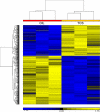Effect of maternal exposure to endocrine disrupting chemicals on reproduction and mammary gland development in female Sprague-Dawley rats
- PMID: 25554385
- PMCID: PMC4464896
- DOI: 10.1016/j.reprotox.2014.12.013
Effect of maternal exposure to endocrine disrupting chemicals on reproduction and mammary gland development in female Sprague-Dawley rats
Abstract
The aim of the study is to determine whether low doses of "endocrine disrupting chemicals" (EDCs) affect the development and proliferative activity of the mammary glands (MGs). Adult parous/nulliparous female Sprague-Dawley (SD) rats were treated from post-natal day (PND) 1 until PND 180 with diethylphthalate (DEP), methylparaben (MPB), triclosan (TCS) and a mixture at doses comparable to human exposure. The doses (mg/kg b.w./day) were: DEP=0.173; MPB=0.105; TCS=0.05. EDC treatment resulted in mortality rates >20% in pups as early as lactation day 7. Significant morphological/histological changes were observed at the end of lactation in the MGs of EDC-treated dams. The total transcriptome profile as well as lactation-related genes in MGs also corroborate the morphological findings as more profound gene expression changes are present only at the weaning period. The study highlights the heightened sensitivity of the MGs during critical windows of exposure, particularly pregnancy and lactation, with an impact on pups' survival.
Keywords: Endocrine disruptors; Mammary glands; Rats; Windows of susceptibility.
Copyright © 2014 Elsevier Inc. All rights reserved.
Figures





Similar articles
-
Endocrine-disrupting chemicals and breastfeeding duration: a review.Curr Opin Endocrinol Diabetes Obes. 2020 Dec;27(6):388-395. doi: 10.1097/MED.0000000000000577. Curr Opin Endocrinol Diabetes Obes. 2020. PMID: 33027070 Free PMC article. Review.
-
Toxicology and carcinogenesis studies of genistein (Cas No. 446-72-0) in Sprague-Dawley rats (feed study).Natl Toxicol Program Tech Rep Ser. 2008 Jan;(545):1-240. Natl Toxicol Program Tech Rep Ser. 2008. PMID: 18685716
-
Changes in mammary histology and transcriptome profiles by low-dose exposure to environmental phenols at critical windows of development.Environ Res. 2017 Jan;152:233-243. doi: 10.1016/j.envres.2016.10.021. Epub 2016 Oct 29. Environ Res. 2017. PMID: 27810681 Free PMC article.
-
Exposure to brominated flame retardants in utero and through lactation delays the development of DMBA-induced mammary cancer: potential effects on subtypes?Front Endocrinol (Lausanne). 2024 Nov 14;15:1429142. doi: 10.3389/fendo.2024.1429142. eCollection 2024. Front Endocrinol (Lausanne). 2024. PMID: 39610845 Free PMC article.
-
Endocrine-disrupting compounds and mammary gland development: early exposure and later life consequences.Endocrinology. 2006 Jun;147(6 Suppl):S18-24. doi: 10.1210/en.2005-1131. Epub 2006 May 11. Endocrinology. 2006. PMID: 16690811 Review.
Cited by
-
Mammary Gland Evaluation in Juvenile Toxicity Studies: Temporal Developmental Patterns in the Male and Female Harlan Sprague-Dawley Rat.Toxicol Pathol. 2016 Oct;44(7):1034-58. doi: 10.1177/0192623316663864. Epub 2016 Sep 9. Toxicol Pathol. 2016. PMID: 27613106 Free PMC article.
-
A novel study evaluation strategy in the systematic review of animal toxicology studies for human health assessments of environmental chemicals.Environ Int. 2020 Aug;141:105736. doi: 10.1016/j.envint.2020.105736. Epub 2020 May 17. Environ Int. 2020. PMID: 32434117 Free PMC article. Review.
-
Exposure to endocrine disruptors during adulthood: consequences for female fertility.J Endocrinol. 2017 Jun;233(3):R109-R129. doi: 10.1530/JOE-17-0023. Epub 2017 Mar 29. J Endocrinol. 2017. PMID: 28356401 Free PMC article. Review.
-
The Association of Bisphenol A and Phthalates with Risk of Breast Cancer: A Meta-Analysis.Int J Environ Res Public Health. 2021 Mar 1;18(5):2375. doi: 10.3390/ijerph18052375. Int J Environ Res Public Health. 2021. PMID: 33804363 Free PMC article. Review.
-
Endocrine-disrupting chemicals and breastfeeding duration: a review.Curr Opin Endocrinol Diabetes Obes. 2020 Dec;27(6):388-395. doi: 10.1097/MED.0000000000000577. Curr Opin Endocrinol Diabetes Obes. 2020. PMID: 33027070 Free PMC article. Review.
References
-
- World health Organization (WHO) Global Assessment of the State-of-the-Science of Endocrine Disruptors. International Programme on Chemical Safety (IPCS) 2002
-
- Brisken C. Endocrine Disruptors and Breast Cancer. Chimia. 2008;62:406–9.
Publication types
MeSH terms
Substances
Grants and funding
LinkOut - more resources
Full Text Sources
Other Literature Sources
Medical

